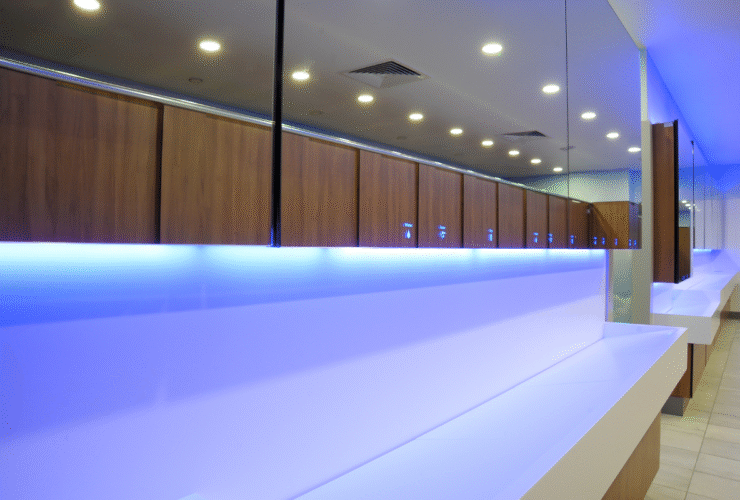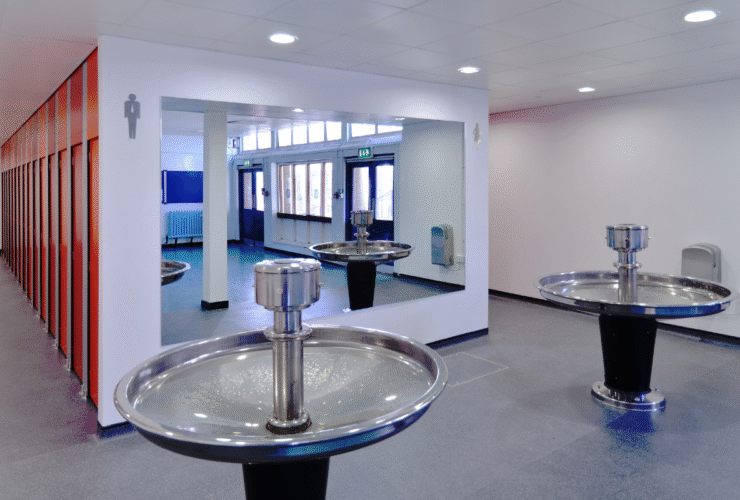In the broader conversation around sustainability and green building practices, washroom design often doesn’t get the spotlight it deserves. Yet, this space can have a significant environmental impact. With advancements in technology and a growing awareness of our environmental footprint, modern washrooms are evolving to become more efficient, eco-friendly, and aligned with environmental strategies. From sensor-activated fixtures to the use of sustainable materials, let’s explore how thoughtful washroom design can help to drive meaningful change.
Water efficiency through smart fixture choice
Water conservation is one of the most critical aspects of sustainable building design, and washrooms are among the top water-consuming areas in any facility. Incorporating water-saving technologies such as sensor-activated taps and flushes can dramatically reduce unnecessary water usage.
- Sensor taps: These taps use infrared or motion sensors to activate water flow only when hands are detected. They prevent taps from being left running unintentionally, saving significant amounts of water. Many models also include aerators, which mix air with water to reduce flow rate while maintaining pressure.
- Low-flow and dual flush toilets: Low-flow toilets use significantly less water per flush than traditional models. Dual-flush systems give users the choice between a low-volume flush for liquid waste and a higher-volume flush for solids, promoting efficient water use tailored to the need.
Energy conservation with smart controls
Energy efficiency in washrooms is just as crucial as water conservation. Smart lighting and drying systems can help reduce energy consumption without sacrificing comfort.
- Sensor lighting: Motion or occupancy sensors ensure lights are only on when the washroom is in use. Pairing these with LED bulbs further reduces energy consumption.
- Efficient hand drying solutions: High-speed, low-energy hand dryers are now a viable alternative to paper towels or dated dryers, offering rapid drying times with significantly reduced energy use.
Durability and performance
The choice of materials in washroom design will significantly impact the longevity of your washroom. By prioritising durable materials that are easy to clean you reduce the need for frequent replacements and harsh cleaning chemicals – supporting a longer-term sustainable strategy, and reducing further expenditure.
Design for maintenance and hygiene
Environmental strategies are not only about conserving resources but also about creating efficient systems that require fewer inputs over time.
- Touch-free design: Minimising touchpoints reduces the spread of germs and the need for intensive cleaning. Sensor-operated soap dispensers, doors, and flushing mechanisms support a cleaner, more hygienic environment with less chemical use.
- Modular components: Fixtures designed for easy repair or replacement can extend the life of the installation and reduce waste from full-unit replacements.
Washrooms as a strategic sustainability opportunity
Sustainable washroom design is more than a trend—it’s a critical component of any building’s environmental strategy. By integrating smart water and energy-saving technologies and designing for durability and hygiene, washrooms can contribute significantly to reducing a building’s environmental footprint. Whether you’re building a new washroom facility or refurbishing an existing one, investing in sustainable washroom solutions is a practical, high-impact step toward a greener future.
At Interfix, we consider all contributing factors when building our washroom designs. If you’re looking for a washroom build or refurbishment partner for an upcoming project, get in touch with our team of washroom experts to see how we can support you.
Interfix Washrooms – Transforming Spaces. Supporting People.



